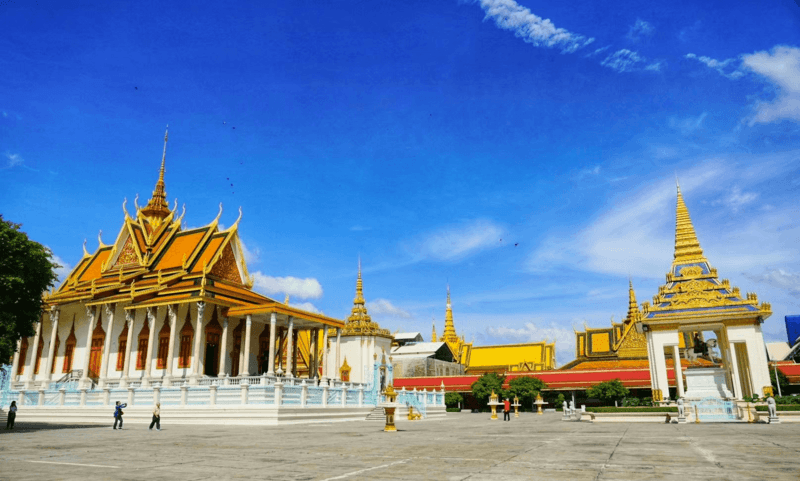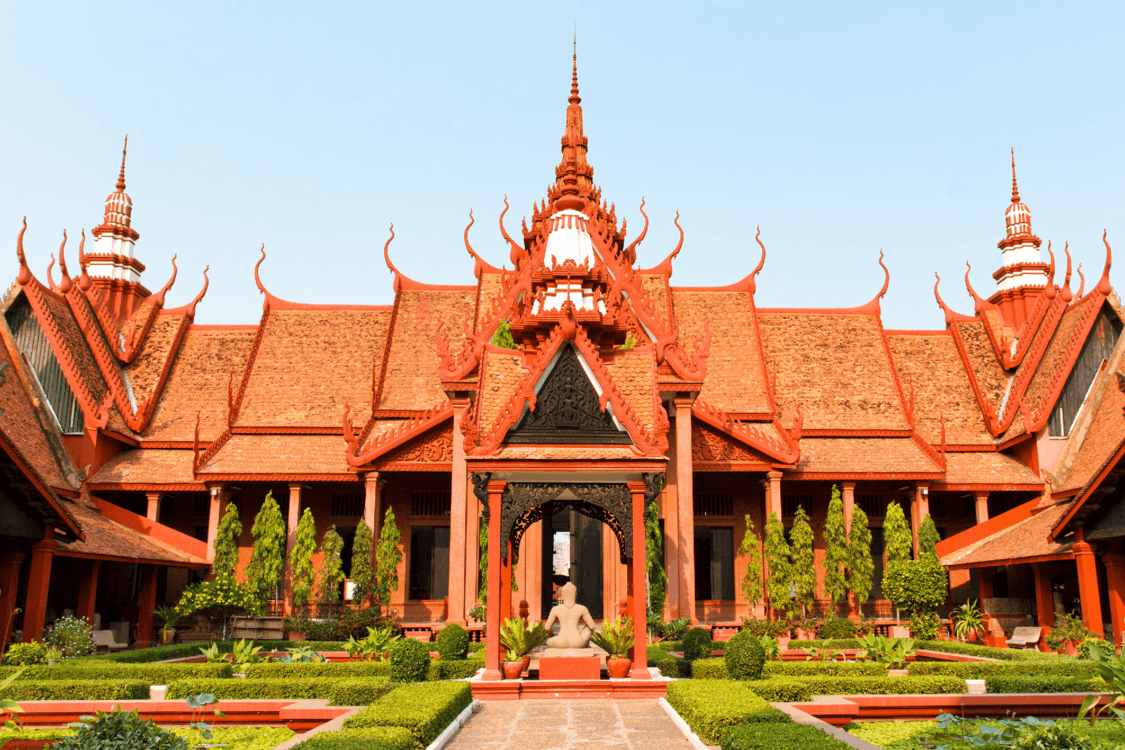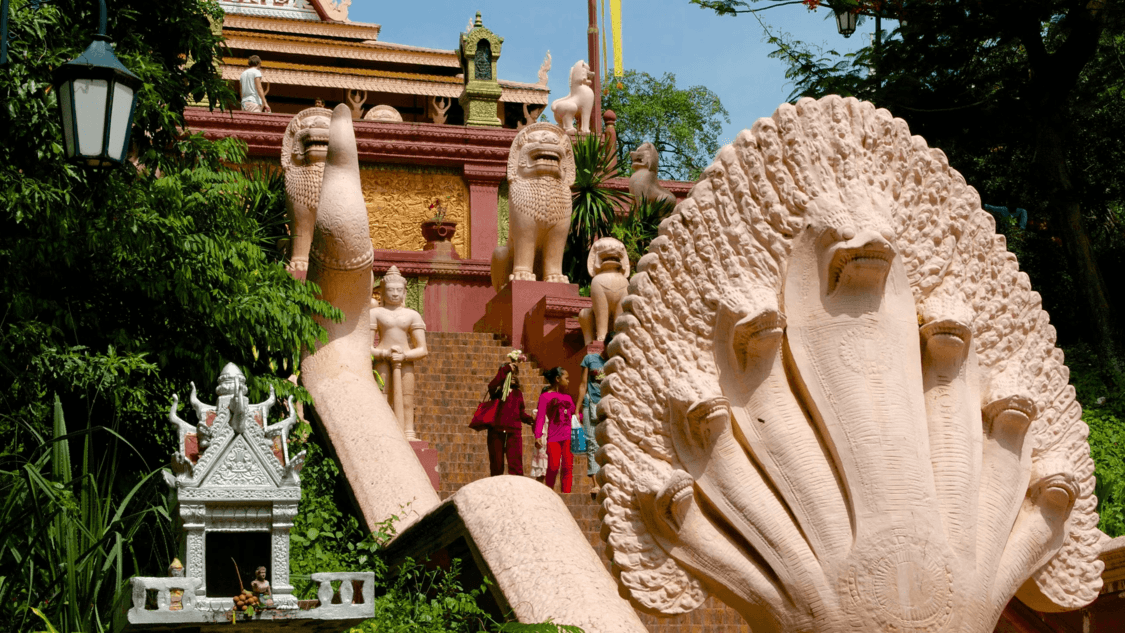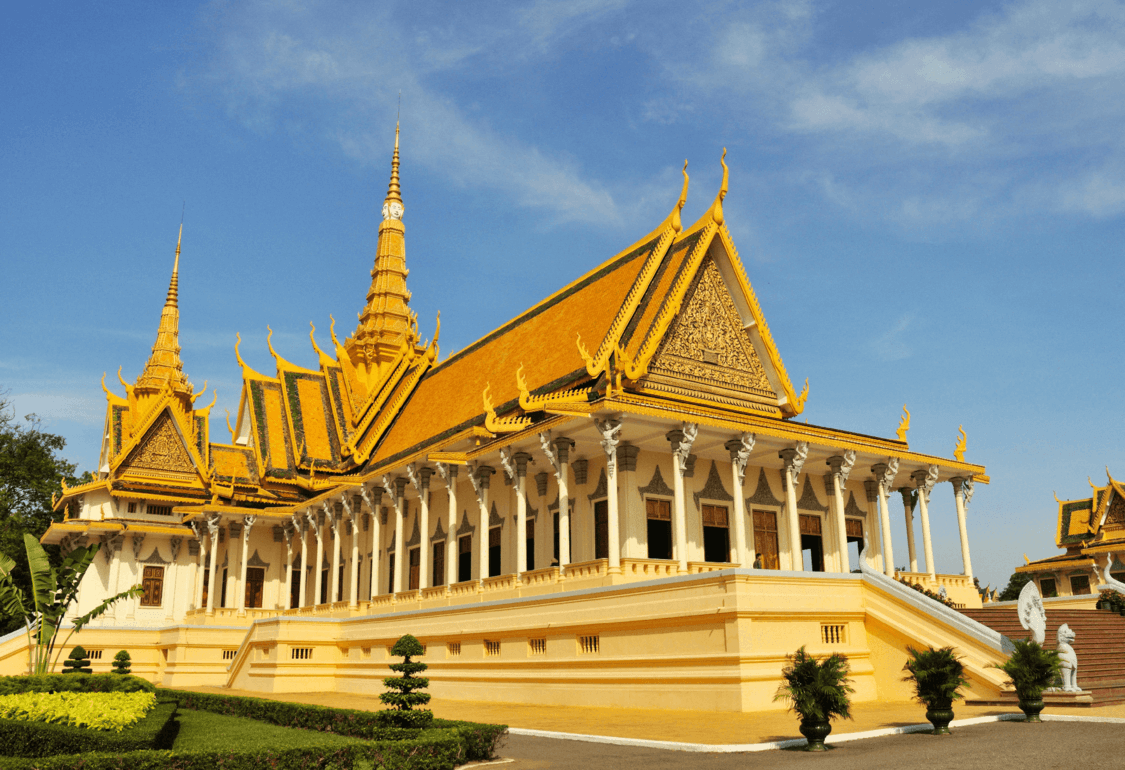Royal Palace, Phnom Penh
The Royal Palace in Phnom Penh, also known as the Four Arms Bay Royal Palace, is named for its location at the confluence of the Mekong, Tonle Sap, and Bassac Rivers. This palace was built by the King of Cambodia between 1866 and 1870, showcasing a style rich in Khmer traditional architecture and religious elements.
The Royal Palace in Phnom Penh is the residence of the King of Cambodia, surrounded by a series of golden roofs and walls, with exquisite and magnificent architecture. It includes more than 20 palaces of various sizes, such as the Throne Hall, the Golden Pavilion, the Silver Pagoda, the Dance Pavilion, and the Treasure Pavilion, each with a spire symbolizing prosperity. Yellow and white are the main colors of the palace, with yellow representing Buddhism and white representing Brahmanism. The corridors of the palace are decorated with exquisite relief murals, modeled after the style of Angkor temples, depicting the achievements of various dynasties and religious stories.
National Museum of Cambodia
The National Museum of Cambodia features gabled roofs, carved doors, and architectural styles reminiscent of ancient Khmer temples, blending traditional Khmer architecture with French colonial influences.
The museum currently houses approximately 15,000 artifacts, with around 2,000 pieces on display at any given time. The collection is extensive, covering different historical periods, including prehistoric times, the early, middle, and late Angkor periods. The main exhibits are categorized into four major types: stone artifacts, bronzes, ceramics, and wooden objects. Additionally, the museum holds a small collection of oil paintings, textiles, photographs, and other archival materials.
Tonle Sap River
The Tonle Sap River is located in the heart of Cambodia, where it merges with the Mekong River, connecting the Tonle Sap Lake and the Mekong River. This area is also the source of the world's fourth-largest freshwater fish resource, with over 150 species of fish inhabiting the river, making it rich in freshwater resources. This abundance of freshwater is mainly attributed to the unique 'reversal flow' phenomenon of the Tonle Sap River. From June to September each year, during the rainy season, the melting snow from the Himalayas causes the Mekong River's water level to rise sharply, causing the water to flow backward into the Tonle Sap River, changing its flow direction. From October to May of the following year, the river water flows back into the Mekong River.
Independence Monument
The Independence Monument is a must-visit attraction in Cambodia, showcasing Angkor-style artistic design. It was built to celebrate Cambodia's complete independence from French colonial rule on November 9, 1953. The Independence Monument is located at the intersection of Norodom Boulevard and Sihanouk Boulevard, situated at the center of Independence Square. This monument was designed by the renowned Cambodian designer Vann Molyvann and was completed in March 1958. It stands 37 meters tall, with 7 tiers, and is topped with a seven-headed naga, a symbol of Cambodian culture. The shape of the monument resembles a five-tiered lotus bud, making it both beautiful and magnificent. Every year on National Day, the King of Cambodia or his representative holds grand celebrations here, making it a site of significant commemorative importance.
Wat Phnom
Climb the high tower to overlook the cityscape and admire the exquisite Angkor-style grottoes. Wat Phnom is the birthplace of Phnom Penh, with an altitude of about 100 meters. At the top of the hill stands the statue of Lady Penh, one of the symbols of Phnom Penh. The temple of Wat Phnom is located at the top of the hill, about 30 meters high, in a quiet and serene environment. The temple is filled with Khmer-style reliefs, majestic and magnificent. When you climb to the top of the hill and ascend the high tower, you can overlook the beautiful scenery of the entire city.
There is also a touching story about Wat Phnom. It is said that in the 14th century, a woman named Penh discovered a Buddha statue drifting along the Mekong River here. She placed the statue on the hill and built a temple to worship it. Over time, this place gradually developed into a bustling town. In the 15th century, the capital of the country moved from Angkor to this place and was officially named 'Phnom Penh,' meaning 'Hill of Lady Penh,' while the local Chinese community called it 'Jinbian.' This story tells the origin of Wat Phnom and its close connection with the naming of Phnom Penh.
Silver Pagoda
The Buddha statue is adorned with 9,584 diamonds, and the floor features luxurious pure silver decorations. The Silver Pagoda, also known as Wat Preah Keo, is located within the Royal Palace in Phnom Penh and is a sacred place where successive kings have worshipped the Buddha. It is named for the more than 5,000 silver tiles embedded in the hall's floor, with a total weight of 5 tons, making it grand and magnificent. The Silver Pagoda is a wooden structure that was expanded by King Norodom Sihanouk in 1962. Inside the hall, numerous precious artifacts are displayed, showcasing the splendor and richness of Khmer culture.
In the Silver Pagoda, there are hundreds of gold and silver treasures, with a centerpiece being an 18K gold Buddha statue weighing 90 kilograms. This statue, adorned with nearly ten thousand diamonds, was made to commemorate King Sisowath and is breathtakingly luxurious. Additionally, the outer walls of the Silver Pagoda are surrounded by many exhibits that fully demonstrate the exquisite Khmer art, including intricate classical dance masks and dozens of pure gold Buddha statues. Their designs are beautiful and craftsmanship is ingenious. These precious items all highlight the magnificence and excellence of Khmer culture.
Wat Ounalom
Exploring the daily life of monks is an experience not to be missed for curious tourists. Wat Ounalom is one of the oldest temples in Phnom Penh and also one of the largest stupas in the city. Its name 'Ounalom' means 'Holy Eyebrow', and it is said that the stupa contains the eyebrow of a high monk. Today, Wat Ounalom serves as the headquarters of the Cambodian Buddhist organization, where visitors can observe monks reading and discussing.
Inside the stupa, there is a relic of the Buddha that was brought back from Ceylon (Sri Lanka) in 1890. Because of this, many dignitaries like to build ash towers in the temple to store the ashes of their ancestors near the Buddha, gradually forming a cluster of towers.

















